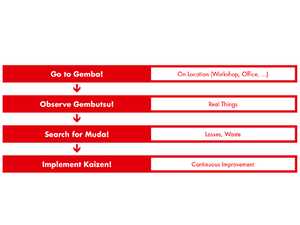
Problem Solving with Kaizen - Four Steps to Success

Even if we divide the elephant “quality” into the slices “structure,” “culture,” and “business cycle,” they are still three quite large and hard-to-digest morsels for a single quality manager. In addition, the journey to a firmly rooted quality culture is not a hundred-meter dash. It is more like a world tour and ranges from the structuring of all processes, goals, and rules, to the cultivation of developed standards, to measurable successes, i.e., the business cycle of quality.
As the person responsible for QM, it is important to take all colleagues along on the journey. This raises two questions: How do I have to design the stages of the journey so that my colleagues accompany me the whole way? What can colleagues do to help me eat the elephant? After all, they are often more likely to be able to tell where something is amiss and, as “diet advisors,” make a valuable contribution to making the pachyderm leaner and thus easier to digest.
Instructions on how to solve problems in a digestible way can be found in the Kaizen toolbox.
1. Go to Gemba! – On Location
When I am asked to solve a problem, I must first determine what the problem is. The best way to do this is to go to the place where the problem occurred – in Japanese “gemba” (“the actual place”). If a product is defective, it is not enough to discuss the error in a conference room “in the ivory tower.” It is much easier to have the defect pattern in mind and meet where the product is manufactured. This can be a machine, an assembly station, or even the computer workstation of an accountant. Only at the “Gemba” are all the conditions in place for the next step:
2. Observe Gembutsu! – Real Things
At the place where the problem occurred it is important to observe everything closely and to get to the bottom of the problem by asking consistent questions. As in many situations in life, the famous W questions help here as well:
- What exactly is the problem? How does it differ from the target state?
- Why has a deviation from the standard occurred?
- When did the problem occur? How often?
- Who is involved in the problem?
- Where else can this problem occur?
- How do we determine if this problem will occur again?
In doing so, do not be afraid to ask “dumb” questions. It is important to grasp the problem in its entirety. This is the only way to determine whether it really is one. Then we can try to find a solution.
3. Search for Muda! – Losses and Waste
I look at this problem through the “wastefulness” lens. Where is the friction? Is it a technical or an organizational problem? For example, was there a misunderstanding, were the rules unclear, was there a lack of standards, were the work instructions incomprehensible, or was there a conflict of goals? Perhaps the problem can also be solved by improving the processes: classic time wasters such as unnecessary searching, waiting, and transporting back and forth can often be eliminated very easily. If processes run smoothly, other errors can also be avoided.
You do not have to be a QM expert to recognize muda, but a little practice is necessary. Regular inspections and data analyses under the guidance of the quality manager are a good way to train colleagues accordingly.
All in all, the identification and categorization of waste is worth a separate article. This time it should suffice to note that with a trained eye the deeper structural causes of many problems can be identified.
4. Implement Kaizen! – Continuous Improvement
If the problem is comprehensively contained – i.e., located and identified – it is much easier to formulate the right actions to take to eliminate the causes of the problem. It is always important to strive for a long-term solution. The goal must be to adapt existing standards or formulate new ones. Anything else is hectic activity that may put out some fires in the short term. But you can be sure that problems “solved” in this manner will resurface elsewhere. You end up running around with the fire extinguisher all the time while the fire continues to spread.
A long-term goal does not mean solving a problem all at once in one giant step. It is better to keep visiting gemba again and again, keep an eye on the gembutsus, and move forward in small steps. Just do not lose sight of the goal in the process.
Infinite Cycle
Follow the four steps and they will almost inevitably fix any problem. This approach is like a natural law of success. Of course, as is almost always the case in quality management, no project is ever over. After all, kaizen stands for continuous and never-ending improvement. The important thing is to always keep the facts in perspective.

Subscribe to Photonics News
Would you like to keep yourself up to date on our products and services? Subscribe here to the German language version of our free Photonics News E-Mail-Newsletter and stay up to date.






















































